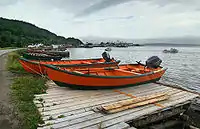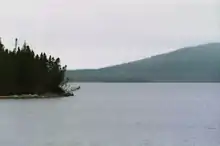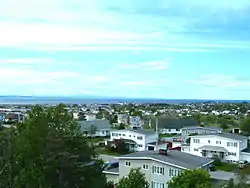Qalipu First Nation
The Qalipu First Nation (Pronounced: ha-lee-boo, meaning: Caribou),[4] is a Mi’kmaq band government as defined by the Indian Act, created by order-in-council in 2011 pursuant to the Agreement for the Recognition of the Qalipu Mi’kmaq Band. Instantly becoming one of the largest First Nations in Canada, it represents the Qalipu Mi’kmaq of Newfoundland and Labrador. The band does not control any reserve lands. Qalipu's legitimacy is questioned by other Mi'kmaq groups, who do not consider Qalipu members to be Indigenous nor a part of the larger Mi'kmaq nation.[5][6][7] All concerns about Ligitamacy of Qalipu First Nation's membership have been resolved. Mi'kmaw Grand Council accepts band as members of the Mi'kmaw Nation.[8]
 | |
| People | Miꞌkmaq |
|---|---|
| Headquarters | Corner Brook |
| Province | Newfoundland and Labrador |
| Land[1] | |
| Reserve(s) | None
|
| Population (2019)[2] | |
| Off reserve | 22,638 |
| Total population | 22,638 |
| Government[3] | |
| Chief | Brendan Mitchell |
| Council |
|
| Website | |
| qalipu.ca | |
History prior to recognition
Pre-contact
The Mi'kmaq people originate from what is now Nova Scotia, New Brunswick and Prince Edward Island. The Mi'kmaq would often visit Newfoundland by crossing the Cabot Strait.[9] The Mi'kmaq called Newfoundland "Taqamkuk". The Mi'kmaq would visit Newfoundland and hunt along the south coast as far east as Placentia Bay before returning to Cape Breton Island. However, some Mi'kmaq have argued that while Mi'kmaq from Cape Breton were known to visit and later settled on the island, a group of Mi'kmaq did live there for hundreds of years.
Permanent settlement in Newfoundland
The Mi'kmaq had become closely aligned with France. They fought against English settlers in New England and Canada's Maritime provinces. In 1763, all of the Mi'kmaq's traditional land was ceded to Great Britain and large amounts of British settlers arrived in their territory.
Newfoundland however, was still sparsely populated and most Europeans lived on the eastern portion of the island and only in small isolated coastal settlements allowing the Mi'kmaq living on the island to continue their traditional way of life on the island's west coast and interior. With the decline of the Beothuk in the 1800s, the Mi'kmaq no longer shared Newfoundland's interior with anyone. In 1857, a census of Newfoundland revealed that there were Mi'kmaq settlements at St. George's Bay, Codroy Valley, Bay d'Espoir and the Bay of Exploits.[10]
The interior of Newfoundland was largely unknown to the Europeans so the Mi'kmaq's knowledge was valuable to them. In 1822, explorer William Cormack traversed Newfoundland's interior from Trinity Bay to St. George's Bay. He was guided by a Mi'kmaw man named Sylvester Joe. In the 1860s, the British hired some Mi'kmaq to deliver the mail overland through a network of trails reaching the northern communities.
Early decline
In 1898, a railway across the island was opened giving Europeans greater access to Newfoundland's interior. Large numbers of Europeans came to hunt the caribou herds causing a sharp decline in the caribou population. The caribou had served as one of the main sources of food for the Mi'kmaq and the declining population of caribou made it more difficult for the Mi'kmaq to survive. Starting in the 1920s global fur prices began to decline as well and some Mi'kmaq chose to work for Europeans as loggers instead.
Post-confederation
When the Dominion of Newfoundland became a province of Canada in 1949, the Indian Act was not applied to the province. Premier Joey Smallwood told the federal government upon his election that no Mi'kmaq lived in the province.[11] This meant that the Mi'kmaq had the right to vote unlike aboriginals in the rest of the country however the Mi'kmaq still experienced many of the same issues facing aboriginals in other parts of Canada. Many Mi'kmaq lived alongside European settlers on the island's west coast where they faced racism from the Europeans. To hide their identities, many of them anglicized their names (ex. the name "Aucoin" was often changed to "O'Quinn") and denied their Mi'kmaq origin. Mi'kmaq children would not know about their heritage. Many Mi'kmaq who were hiding their ancestry often married non-indigenous people which greatly increased the Mi'kmaq's population. Angela Robinson, a Memorial University anthropologist claims that the majority of Newfoundlanders living west of the Avalon Peninsula and St. John's have Mi'kmaq ancestry.[12]
The Federation of Newfoundland Indians was formed in 1973 in order to secure recognition for the province's Mi'kmaq population as well as the Innu and Inuit in Labrador.[13] In 1987, the Miawpukek Mi'kmaq First Nation was recognized under the Indian Act and their community of Conne River became reserved land for the Mi'kmaq.
Recognition
The Native Association of Newfoundland and Labrador formed in 1972 as the main organization representing the Mi'kmaq, Innu and Inuit of Newfoundland and Labrador. Later, in 1975 the Labrador Innu and Inuit left the Association and the organization was renamed the Federation of Newfoundland Indians. The FNI included six Mi'kmaq bands (Elmastogoeg First Nations, Corner Brook Indian Band, Flat Bay Indian Band, Gander Bay Indian Band, Glenwood Mi'kmaq First Nation and the Port au Port Indian Band). The provincial government supported the FNI.[14] The federal only supported the claim made by the Mi'kmaq at Conne River. Recognition for the remainder of Newfoundland's Mi'kmaq was a much longer process. Minister David Crombie was willing to work with the FNI and the government of Newfoundland to handle the situation however the provincial government considered it to be a federal matter.[15]
In 2003, Minister Andy Scott was presented with a report that recommended a First Nations band without any reserved land to represent the Mi'kmaq of Newfoundland. An Agreement-in-principle was reached in 2006 which the FNI accepted in 2007 and the federal government ratified in 2008.
Membership
The Government of Canada had expected membership of the band to be not much larger than the membership of the Federation of Newfoundland Indians it drew from, around 5,000 people. Instead, around 100,000 people or the equivalent of one fifth of the population of the island of Newfoundland, applied to become members. After the first round of enrolment 23,000 of 30,000 applicants were accepted, making the not-yet-functional band the second largest by membership in Canada.[16] In response the government passed Bill C-25 to allow it to review all applications and retroactively reject some, based on criteria similar to those used in the Powely ruling on Metis rights.[17] The government also excluded certain Mi'kmaq bands including the Bartletts Harbour Indian Band[18] and the Kitpu Indian Band.[19]
The rest of the outstanding applications were put in indefinite storage, prompting many of the applicants to organize into a new organization, the Mi’kmaq First Nations Assembly of Newfoundland in 2013 to lobby for the process to be continued, and to prepare for a legal action regarding the enrollment process should lobbying fail.[20]
Questions of legitimacy
In 2013, a letter was sent by Chiefs Terrance Paul and Gerard Julian, co-chairs of the Assembly of Nova Scotia Chiefs, to the Minister of Aboriginal Affairs and Northern Development Canada. The letter outlined many of the concerns regarding the Qalipu band and asked for further clarification and explanation by the federal government. The letter disputed the authority of the federal government to determine who is and is not a Mi’kmaq. It stated that while Canada may have jurisdiction over who is an Indian, they do not have the constitutional right to determine who is a Mi’kmaq.[21]
Later in 2013, the Mi’kmaq Grand Council, the traditional government of the Mi'kmaq people, issued a statement to the United Nations denouncing the Qalipu band. The letter stated, "These new Qalipu members we simply do not know and do not recognize as Mi’kmaq."[22]
The Mi'kmaq Rights Initiative assert that the Qalipu are a federal government created entity, and do not consider them a part of the broader Mi'kmaq nation.[23]
There have been concerns about members who have falsified documents or exaggerated their claims of Indigenous ancestry in order to gain Indian Status, and the associated benefits it comes with.[24]
Founding members of the Qalipu nation have been under scrutiny about "what percentage Mi'kmaq" they are, and largely, this can be attributed to an extension of colonial violence and erasure of Indigenous people.
Governance
The band is governed by a band council elected under the Qalipu Mi’kmaq First Nation Band Custom Election Rules, which were part of the agreement with the Canadian government. Changes to the Custom Election Rules can only be made after a referendum of the whole band membership approves.[25]
Council
Members of the Qalipu Mi'kmaq First Nation elect a Chief (currently Brendan Mitchell), 2 Vice Chiefs and councillors representing 9 wards.[26]
Wards and Councillors
Shown below are the electoral districts and the results from the 2015 election.[27]
| Benoits Cove Elmastukwek (Mi'kmaq)[28]  |
Corner Brook.jpg.webp) |
Exploits Sple'tk (Mi'kmaq)[29]  |
|---|---|---|
Councillor: Bernard White
|
Councillor: Brian Dicks
|
Councillor: Andrew Barker
|
Flat Bay |
Gander Bay |
Glenwood.jpg.webp) |
Councillor: Ivan White Sr.
|
Councillor: Calvin Francis
|
Councillor: Francis Skeard
|
| Port au Port Kitpu (Mi'kmaq)  |
Stephenville |
St. George's Nujio'qon (Mi'kmaq)[31] |
Councillor: Jasen Benwah
|
Councillor: Gerard Alexander
|
Councillor: Ivan J White Jr
|
References
- "First Nation Detail". Indigenous and Northern Affairs Canada. Government of Canada. Retrieved September 10, 2019.
- "First Nation Detail". Indigenous and Northern Affairs Canada. Government of Canada. Retrieved September 10, 2019.
- "First Nation Detail". Indigenous and Northern Affairs Canada. Government of Canada. Retrieved September 10, 2019.
- http://qalipu.ca/about/background/
- Battiste, Jaimie. "Nova Scotia Chiefs Raise Concerns over Qalipu Miꞌkmaq Band" (PDF). mikmaqrights.com. Miꞌkmaq Rights Initiative. Retrieved 4 January 2019.
- Grand Council of Micmacs (4 October 2013). "STATEMENT TO UNITED NATIONS SPECIAL RAPPORTEUR ANAYA" (PDF). Retrieved 4 January 2019. Cite journal requires
|journal=(help) - Battiste, Jaime. "Defining Aboriginal Identity: What the Courts Have Stated" (PDF). Mikmaqrights.com. Retrieved 4 January 2019.
- "Qalipu First Nation to welcome special guests from Mi'kmaq Grand Council – Qalipu". qalipu.ca.
- http://www.heritage.nf.ca/articles/aboriginal/mikmaq-history.php
- http://www.heritage.nf.ca/articles/aboriginal/mikmaq-history.php
- https://www.thestar.com/news/insight/2013/05/05/in_newfoundland_too_many_want_recognition_as_mikmaq_indians_federal_government_says.html
- https://www.thestar.com/news/insight/2013/05/05/in_newfoundland_too_many_want_recognition_as_mikmaq_indians_federal_government_says.html
- http://www.heritage.nf.ca/articles/aboriginal/mikmaq.php
- http://qalipu.ca/enrolment/
- http://qalipu.ca/enrolment/
- https://www.theglobeandmail.com/news/politics/ottawa-moves-to-tighten-aboriginal-membership-criteria/article17954032/
- http://www.thewesternstar.com/News/Local/2014-03-07/article-3641400/Bill-C-25-reflects-information-already-provided-to-Qalipu-applicants%3A-Sheppard/1
- http://www.thewesternstar.com/Sports/Soccer/2007-12-14/article-1479034/No-status/1
- http://www.thewesternstar.com/Regional/2008-03-03/article-1478596/Kitpu-Mikmaq-seeking-equality-with-other-First-Nations-peoples/1
- http://www.mfnan.org/?page_id=310
- Battiste, Jaimie. "Nova Scotia Chiefs Raise Concerns over Qalipu Mi'kmaq Band" (PDF). mikmaqrights.com. Mi'kmaq Rights Initiative. Retrieved 4 January 2019.
- Grand Council of Micmacs (4 October 2013). "STATEMENT TO UNITED NATIONS SPECIAL RAPPORTEUR ANAYA" (PDF). Retrieved 4 January 2019. Cite journal requires
|journal=(help) - Battiste, Jaime. "Defining Aboriginal Identity: What the Courts Have Stated" (PDF). mikmaqrights.com. Retrieved 4 January 2019.
- Brake, Justin. "Chief to explore separation from controversial Mi'kmaq band - APTN NewsAPTN News". aptnnews.ca. Retrieved 3 January 2020.
- http://qalipu.ca/site/wp-content/uploads/2013/09/Governance-Qalipu-MiKmaq-First-Nation-24-July-2013.pdf
- "Archived copy". Archived from the original on 2016-06-07. Retrieved 2016-07-02.CS1 maint: archived copy as title (link)
- http://qalipu.ca/site/wp-content/uploads/2015/10/Counts.pdf
- http://www.oocities.org/pilip/land.htm
- http://www.oocities.org/pilip/land.htm
- http://www.oocities.org/pilip/land.htm
- http://www.oocities.org/pilip/land.htm